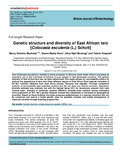| dc.description.abstract | Taro [Colocasia esculenta (L) Schott] is mainly produced in Africa by small holder farmers and plays an
important role in the livelihood of millions of poor people in less developed countries. The genetic
diversity of East African taro has not been determined. This study utilizes six microsatellite primers to
analyze five populations of taro from three different regions of East Africa. Plant material consisted of
98 taro cultivars obtained from East Africa (Kenya, Tanzania and Uganda). Principal component
analysis of microsatellite data indicated variation but did not show any distinct structure. Population
diversity estimate was relatively low with the highest being 0.27, for accessions sourced from Lake
Victoria basin. Analysis of molecular variance (AMOVA) revealed most variation among individuals
within population at 79%. Nei’s genetic distance showed that relatedness is not based on geographical
proximity. Based on these findings, this study proposes establishment of a regional collection that will
be conserved and ensure a broad genetic base for available varieties and enable development of
improved varieties through breeding programmes.
Key words: Genetic diversity, simple sequence repeats (SSRs), taro. | en_US |

